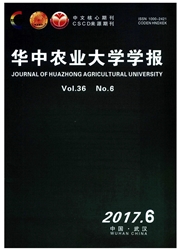

 中文摘要:
中文摘要:
从广东省韶关和梅州2个烟草产区采集了来自8个县市的共38个烟草青枯菌菌株,对病菌的生物型、致病型和遗传多样性进行了测定,结果表明广东烟草青枯菌全部为生物型Ⅲ。通过在红花大金元,K326,岩烟97和系3等4个烟草鉴别品种上的致病性反应,将广东烟草青枯菌分为强致病力、中等致病力和弱致病力3种致病型,其中以中等致病力菌株为主,占78.9%;强致病力菌株占13.2%;弱致病力菌株占7.9%。从116个RAPD通用引物中筛选出10条引物,用于对38个烟草青枯菌株DNA的RAPD分析,扩增条带表现出明显的多态性,条带主要聚集在0.3~4.0kb之间。聚类分析这38个菌株可分为2个组群,即组群A和组群B。组群A中又可以分为7个亚组(A1、A2、A3、A4、A5、A6、A7);组群B也含有4个亚组(B1、B2、B3、B4)。研究结果还表明,广东烟草青枯菌菌株RAPD组群的划分与菌株的寄主来源有一定的相关性,但与地理区域、生物型和致病型没有明显的相关性;生物型不能反映烟草青枯菌菌系的差异。 04—0463—06
 英文摘要:
英文摘要:
Thirty-eight representative strains of Ralstonia solanacearum from tobacco collected from 8 regions in Shaoguan and Meizhou, Guangdong Province. Some studied were done on their biovar, pathogenicity and genetic diversity. The results showed that all strains were belongs to biovar Ⅲ. Strains were tested for their pathogenicity when inocated on the four differentiated hosts such as Honghuadajinyuan, K326, Yanyan 97 and G3. Three pathogenic groups were conducted. The amount of strains in moderate, high and low pathogenicity were 78. 9%, 13.2% and 7. 9% respectively. The genetic diversity of 38 isolates of R. solanacearum was assessed by RAPD with 10 primers seleceted from 116 random primers. The lenth of amplified fragments were almost between 0. 3 to 4. 0 kb. RAPD clustering results on the strains showed that R. solanacearum strains from Guangdong province could division A and B, di- vision A could be separated into 7 groups(A1, A2, A3, A4, A5, A6, A7), B could be divided into 4 groups (B1 ,B2,B3,1M). The study showed that RAPD clustering were high relation between the strain genetic diversity and their host origin. Biovar could not showed the difference in R. solanacearum strains from Tobacco.
 同期刊论文项目
同期刊论文项目
 同项目期刊论文
同项目期刊论文
 期刊信息
期刊信息
